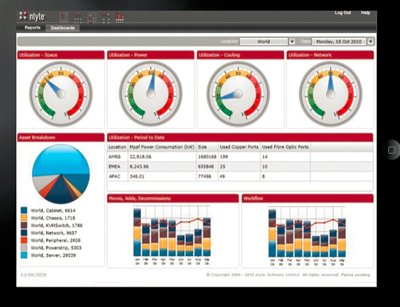In 2012, businesses will start to see the benefits of managing the data center as a single entity – taking into account all tolerances, dependencies, technologies and reports – affording maximum control of the data center environment.
To continue managing the data center environment without an accurate understanding of the facilities available will leave organizations with critical inaccuracies that could result in power outages, an inability to provide key services and spiralling costs due to badly provisioned resources.
Until now, technology purchasing inside the data center has been fragmented and focused on facilities such as buildings, power and cooling, with managers trying to gain better control using quick fixes that often work in silos and distort analyses of the data center environment. This makes boardroom and budgetary decisions based on business plans far removed from what is actually needed in the data center.
As an example, technologies such as radio-frequency identification technology (RFID) scanners or barcode readers are becoming more common in the data center. These keep track of asset changes and speed up application deployment in support of new business lines.
But if this information is not also linked to power consumption requirements and virtualization instances there may be unforeseen power outages and application failures, which have the potential to grind business to a halt.
Can we comply?
According to analyst firm Gartner, business intelligence is one of the fastest growing software markets as organizations continue to look for ways to develop smarter and more agile business. It is crucial that reporting in the data center is a true representation of reality, as there is little value in best guesses.
The ability to capture real-time snapshots of the data center, as well as making longer term accurate predictions, is long overdue, especially as service and data requirements are ever-expanding and the adoption of the Cloud, as the provider of unlimited capacity, continues to run ahead of reality.
Furthermore, varying levels of detail need to be accessible – from board level overviews that can indicate target progression to more granular analytics that can help engineers identify problems swiftly. Ensuring reports are synchronized with reality means that both short-term and long-term projections are accurate, and fundamentally creates a more reliable data center.
Synchronization by DCIM
Organizations will likely investigate a variety of ways in which to synchronize all assets, provisioning and reporting inside the data center, but the scale of data that is now in play makes obtaining a complete picture increasingly harder to achieve.
Traditional tools such as Excel spreadsheets and Visio diagrams can no longer keep up with the high frequency of change and the sheer amount of technologies that are operational inside the data center, and so are falling way below the mark when it comes to delivering a holistic data center strategy.
It has been many years since we’ve seen our finance, sales and marketing teams run their operations using spreadsheets. These have long been replaced with fully functional enterprise resource planning, customer relationship management and marketing automation solutions, but we continue to expect our data centers to use such outdated approaches.
Attempts at complete control in the data center are made worse by the ambiguity surrounding the term DCIM (data centre infrastructure management). With a host of providers claiming to deliver DCIM capabilities, it is proving increasingly difficult for organizations to find a solution that truly meets their individual needs and coordinates all the assets inside.
A genuine DCIM solution should manage the facility in its entirety, including assets, technology, projects, integration with facilities, power and cooling tools, plus enable workflows and reports. Critically, only a solution that takes into account the whole of the data center can claim to truly manage the infrastructure.
With ever-constricting margins a staple of business life, and energy costs putting pressure on data center operations, 2012 will see organizations make numerous changes in an effort to get a better grip on data center budgets and usage, as well as mitigate problems.
Better data center management poses a huge opportunity to address these issues, but to be successful it needs to be completely synchronized with what is actually happening on the data center floor.
From availability and tolerances, through to the integration of technology and holistic reports, all elements of the data center must work together. Once achieved, a well-managed, adequately provisioned data center can be delivered. The question is how many enterprises will identify the right DCIM solution to implement this?
This article first appeared FOCUS issue 21. To sign up for your copy and DatacenterDynamics updates, click here.

